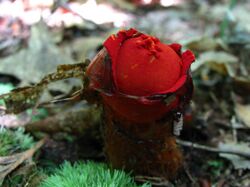Chemistry:Calostomal
From HandWiki
| Names | |
|---|---|
| Preferred IUPAC name
(2E,4E,6E,8E,10E,12E,14E)-16-Oxohexadeca-2,4,6,8,10,12,14-heptaenoic acid | |
| Identifiers | |
3D model (JSmol)
|
|
| ChemSpider | |
PubChem CID
|
|
| UNII | |
| |
| |
| Properties | |
| C16H16O3 | |
| Molar mass | 256.301 g·mol−1 |
Except where otherwise noted, data are given for materials in their standard state (at 25 °C [77 °F], 100 kPa). | |
| Infobox references | |
Calostomal is an organic compound that has a carboxylic acid and an aldehyde group. It is an orange solid that is extracted from the mushroom Calostoma cinnabarinum, hence its name. The structure of this compound was confirmed by NMR and mass spectrometry of the methyl ester derivative.[1] This compound is a polyene; its conjugated system accounts for its intense color, similar to lycopene found in tomatoes.
References
- ↑ Gruber G, Steglich W. (2007). "Calostomal, a polyene pigment from the gasteromycete Calostoma cinnabarinum (Boletales)". Zeitschrift für Naturforschung B 62 (1): 129–131. doi:10.1515/znb-2007-0120. http://www.znaturforsch.com/ab/v62b/s62b0129.pdf.
 |


